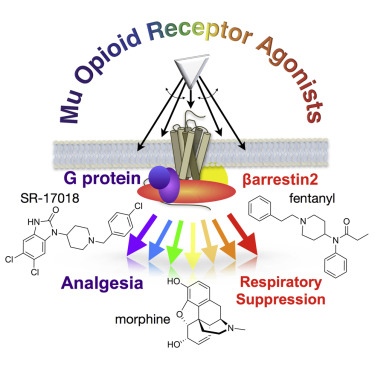Our official English website, www.x-mol.net, welcomes your feedback! (Note: you will need to create a separate account there.)
Bias Factor and Therapeutic Window Correlate to Predict Safer Opioid Analgesics.
Cell ( IF 64.5 ) Pub Date : 2017-Nov-16 , DOI: 10.1016/j.cell.2017.10.035 Cullen L. Schmid , Nicole M. Kennedy , Nicolette C. Ross , Kimberly M. Lovell , Zhizhou Yue , Jenny Morgenweck , Michael D. Cameron , Thomas D. Bannister , Laura M. Bohn
Cell ( IF 64.5 ) Pub Date : 2017-Nov-16 , DOI: 10.1016/j.cell.2017.10.035 Cullen L. Schmid , Nicole M. Kennedy , Nicolette C. Ross , Kimberly M. Lovell , Zhizhou Yue , Jenny Morgenweck , Michael D. Cameron , Thomas D. Bannister , Laura M. Bohn

|
Biased agonism has been proposed as a means to separate desirable and adverse drug responses downstream of G protein-coupled receptor (GPCR) targets. Herein, we describe structural features of a series of mu-opioid-receptor (MOR)-selective agonists that preferentially activate receptors to couple to G proteins or to recruit βarrestin proteins. By comparing relative bias for MOR-mediated signaling in each pathway, we demonstrate a strong correlation between the respiratory suppression/antinociception therapeutic window in a series of compounds spanning a wide range of signaling bias. We find that βarrestin-biased compounds, such as fentanyl, are more likely to induce respiratory suppression at weak analgesic doses, while G protein signaling bias broadens the therapeutic window, allowing for antinociception in the absence of respiratory suppression.
中文翻译:

偏倚因素和治疗窗口相关,可预测更安全的阿片类镇痛药。
提出了有偏激性激动作为在G蛋白偶联受体(GPCR)靶标下游分离所需药物反应和药物不良反应的手段。在这里,我们描述了一系列的μ阿片受体(MOR)选择性激动剂的结构特征,该激动剂优先激活受体以偶联至G蛋白或募集βarrestin蛋白。通过比较在每种途径中MOR介导的信号传导的相对偏倚,我们证明了一系列抑制信号传导偏倚的一系列化合物中的呼吸抑制/伤害感受治疗窗口之间存在很强的相关性。我们发现βarrestin偏倚的化合物(例如芬太尼)在较弱的镇痛剂量下更可能诱导呼吸抑制,而G蛋白信号偏向则扩大了治疗范围,从而在没有呼吸抑制的情况下具有镇痛作用。
更新日期:2017-11-19
中文翻译:

偏倚因素和治疗窗口相关,可预测更安全的阿片类镇痛药。
提出了有偏激性激动作为在G蛋白偶联受体(GPCR)靶标下游分离所需药物反应和药物不良反应的手段。在这里,我们描述了一系列的μ阿片受体(MOR)选择性激动剂的结构特征,该激动剂优先激活受体以偶联至G蛋白或募集βarrestin蛋白。通过比较在每种途径中MOR介导的信号传导的相对偏倚,我们证明了一系列抑制信号传导偏倚的一系列化合物中的呼吸抑制/伤害感受治疗窗口之间存在很强的相关性。我们发现βarrestin偏倚的化合物(例如芬太尼)在较弱的镇痛剂量下更可能诱导呼吸抑制,而G蛋白信号偏向则扩大了治疗范围,从而在没有呼吸抑制的情况下具有镇痛作用。



























 京公网安备 11010802027423号
京公网安备 11010802027423号